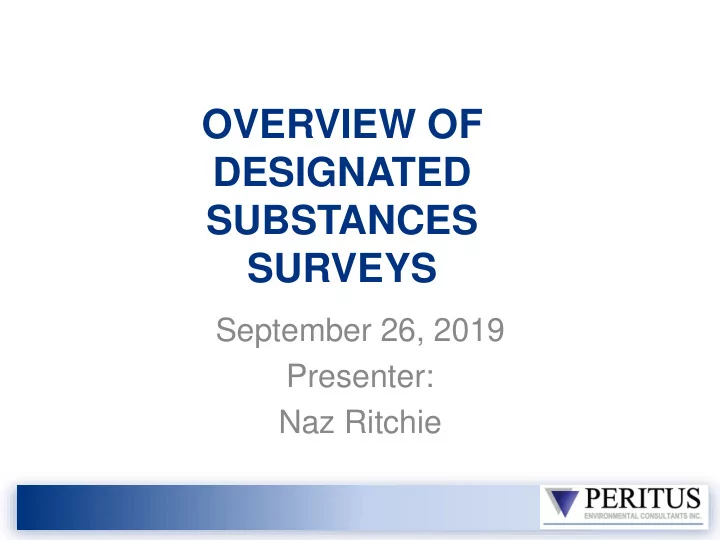

OVERVIEW OF DESIGNATED SUBSTANCES SURVEYS September 26, 2019 Presenter: Naz Ritchie
Regulatory Requirements • Section 30 of the Ontario “Occupational Health and Safety Act” (OHSA) • Designated Substances are defined under Ontario Regulation 490/09 • Asbestos: Ontario Regulation 278/05 • Disposal: Ontario Regulation 347
Renovation/Construction • Section 30 (OHSA) requires owners or their representative to prepare a Designated Substances Survey (DSS) for hazardous materials in a facility • Need to provide this to general contractors before signing a contract • Notice of Project: Report designated substances likely to be used, handled or disturbed during the project
Designated Substances There are 11 designated substances defined by the regulations: • Acrylonitrile • Isocyanates • Arsenic • Lead • Asbestos • Mercury • Benzene • Silica • Coke Oven Emissions • Vinyl Chloride • Ethylene Oxide
Uses of Designated Substances • Acrylonitrile: used in manufacture of plastics • Arsenic: semi-conductor, wood preservative, poison, medicine and chicken feed • Asbestos: mineral used in many applications • Benzene: gasoline, drugs, detergents and medicine • Coke Oven Emissions: Emissions are used for plastics, solvents, dyes, paints and insulation
Uses of Designated Substances • Ethylene Oxide: antifreeze, pesticides and sterilant • Isocyanates: polyurethane foams, surface coating and spray foam insulation • Lead: paint, pipes, gasoline and batteries • Mercury: thermostats and fluorescent light bulbs • Silica: concrete blocks, food additives and drugs • Vinyl Chloride: PVC pipes, daughter product of PCE and TCE
Other Hazardous Materials Not included on the list of designated substances • PCBs: Transformer oils and fluorescent lights • UFFI: Insulation • Ozone Depleting Substances (CFCs, HCFCs): HVAC units and refrigerants • Mould
What is involved in DSS? • Designated Substances Survey Include: – Field Survey – Sampling and Laboratory Analysis – Reporting • Conduct either Project-Specific DSS or a General DSS • Can combine a DSS with a Phase I Environmental Site Assessment (ESA)
Field Survey • Review history of building including age (pre or post 1990) and major renovations • Use of building • Walkthrough the building • Look for common materials that may contain designated substances • Collect samples
Sampling and Analysis • Relationship with various labs • Sampling is primarily focused on asbestos and lead • Visual observation of other materials including fluorescent lights (mercury and PCBs) and silica • Also look for evidence of mould
DSS Reporting • Executive summary • Scope of Investigation and Methods • Evaluation of Results • Information about designated substances including locations, quantity, type and condition • Findings and Recommendations • Photo Log • Figures
Asbestos Sampling • Friable or Non-Friable • If not being disturbed, can remain in place • Samples collected in multiples of 3 for most materials • Sprayed fireproofing, drywall joint compound, texture coat and plaster: number of samples depend on quantity present – If 1,000 to 5,000 ft 2 , then 5 samples, – Greater than 5,000 ft 2 , then 7 samples
Common Asbestos Containing Materials (ACM) • Ceiling Tiles (Date Stamp) • Vinyl Floor Tiles (12 x 12 or 9 x 9) and Sheets • Drywall Joint Compound • Caulking • Mastics • Roofing Layers (Asphalt, Felt and Vapour Barrier)
Examples of ACM Pipe Wrap and Thermal Insulation
Examples of ACM – Sneaky Pipe Wrap Pipe Wrap ACM Floor Tile
Vermiculite • Mineral used for insulation and other commercial products • Vermiculite is NOT asbestos • Vermiculite deposits were contaminated with asbestos (Montana)
Examples of Lead Application • Lead Paint • Lead Pipes • Batteries • Ammunition • Solders
Silica • Concrete Floor • Concrete Block Walls
Abatement • Identify the type of abatement approach: – Type 1: Low Risk, Hand held tools – Type 2: Medium Risk: Non-Friable materials with power tools or < 1m 2 of friable ACM – Type 3: High Risk, Enclosures and Air Clearance Testing • Work with a qualified asbestos abatement contractor • Abatement oversight and reporting
Questions?
Thank you For more information or any questions, please contact: Naz Ritchie General Manager Peritus Environmental Consultants Inc. 519-594-0018 naz.ritchie@peritusenv.com www.PeritusEnv.com
Recommend
More recommend